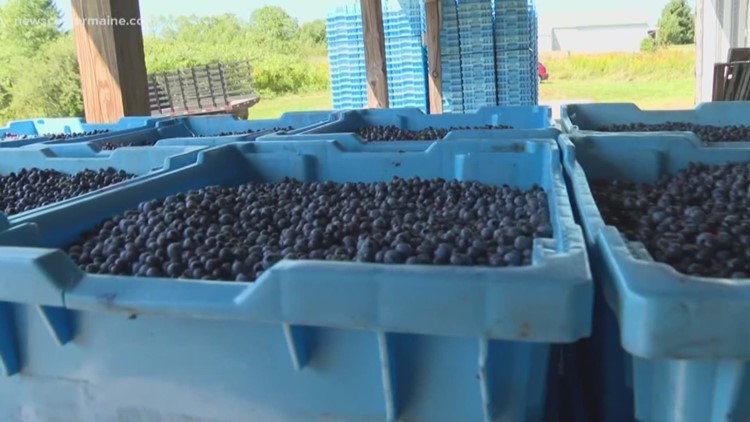MAINE, USA — If you have been struggling with growing desirable blueberry yields this season, a new University of Maine study may have a solution to help you reach your blueberry harvesting goals.
The recent study determined that by mixing nanocellulose with liquid fertilizer, wild blueberry yields may increase.
Ph.D. Candidate Rafa Tasnim, a research assistant at the Zhang Lab in UMaine's School of Biology and Ecology, said nanocellulose is a natural polymer that is derived from the wood in trees and plants, which the state of Maine has plenty of.
"Since it’s natural, it’s environment-friendly, harmless, and potentially beneficial for different purposes," Tasnim told NEWS CENTER Maine. "In our study, we tried to explore if it would be beneficial in agricultural system[s]. And we started with wild blueberries since this crop system is culturally and economically very important in Maine, and [the] University of Maine is producing plenty of nanocellulose (1 ton [of] cellulose nanofiber (CNF) per day)."
Tasnim said the study began in 2020, testing the CNF on wild blueberries by mixing it with Poma fertilizer, a foliar fertilizer that is commercially available. The test revealed "promising results" based on the wild blueberry’s physiological responses, development, and yield.
"Then, we wanted to understand in [a] deeper level how that mixture is interacting with the plants, especially with the wild blueberry leaves, because we sprayed those mixtures on leaves so that the leaves can uptake nutrients quickly," Tasnim said.
After the initial results, Tasnim explained that she and her colleagues came up with the hypothesis that CNF, when mixed with a foliar fertilizer, will help the fertilizer adhere to the plant's leaves better, allowing the leaves to absorb the nutrients more efficiently, even amid rainy, windy weather.
"We also wanted to understand how the CNF was reacting with the Poma foliar fertilizer," Tasnim said. "That’s how we came up with our recent study, where we observed through microscopic images that the CNF helped the Poma foliar fertilizer to break into smaller molecules, and the stomata (pores on the leaves) could uptake those smaller water/nutrient molecules easily and also, the CNF could efficiently stick to the leaf hairs (trichomes). This phenomena could lead to the higher fruits yield for the wild blueberries."
A previous UMaine study revealed that some blueberry fields in Maine are warming faster than others due to warmer and drier conditions. It raises the question: Will nanocellulose mixed with a foliar fertilizer help increase blueberry yields all over Maine, or only in certain areas?
Tasnim said this question is still being explored, as her study on CNF and Poma was limited to research at UMaine's Blueberry Hill Farm Lab in Jonesboro.
However, Tasnim also said that her fellow UMaine researcher Dr. YongJiang Zhang, an assistant professor of plant physiology at the School of Biology and Ecology, has big plans in the works.
"[A]s far as I am aware, big plans are undergoing, like Dr. YongJiang Zhang and Dr. Lu Wang ... are planning to extend this research in terms of climate change, testing if it would help under warmer, drought condition[s] or if it would help to avoid any unpredictable late frost damages for the wild blueberries," Tasnim said.
"Based on our current result, we foresee that nanocellulose mixed with foliar fertilizer could prove successful in all of Maine's climates amid climate change, warmer temperatures, and drier conditions," Zhang told NEWS CENTER Maine. "That's because the physical interactions among nanocellulose, foliar fertilizer, and leaves are not climate-dependent. And the effect should apply to other crops like strawberries, and potatoes, too. We welcome collaborations with researchers working on other crops."
Zhang also predicts that mixing nanocellulose with foliar fertilizer could prove to be a possible and successful long-term solution for blueberry growers, especially amid climate change.
"The nanocellulose will improve the fertilizer uptake efficiency. Thus, it can reduce fertilizer use, increase profitability, and also reduce the negative impact of fertilizers on the environment," Zhang explained. "Because drought will limit nutrient availability in soils, nanocellulose mixed with foliar fertilizer can secure nutrient supply to wild blueberry crops and improve the resilience of the crop production to drought. In addition, nanocellulose has been proven to protect cherries and apples from spring frost damage. So, we plan to test the use of nanocellulose in protecting wild blueberries from frost damage, too."
With springtime frost becoming more frequent over the past few years, nanocellulose has the potential to be the end-all solution for increasing wild Maine blueberry yields in upcoming years.
"Also, we will test whether nanocellulose on the leaf surface can protect crops from disease infection," Zhang continued. "Overall, we think nanocellulose could be a potential long-term solution and a 'swiss army knife' to enhance the resilience of wild blueberry production to climate change."
Whether or not this agricultural solution will be affordable and easily accessible to farmers, both growing blueberries personally or commercially, has yet to be determined.
Tasnim said a different application rate of CNF to come up with a recommended rate for farmers is necessary first to do a cost-benefit analysis determining future costs. She added that the nanocellulose will need to be tested with other fertilizers first to measure this method's efficiency.
For more information about blueberry farming in Maine and additional UMaine research on the topic, click here.



